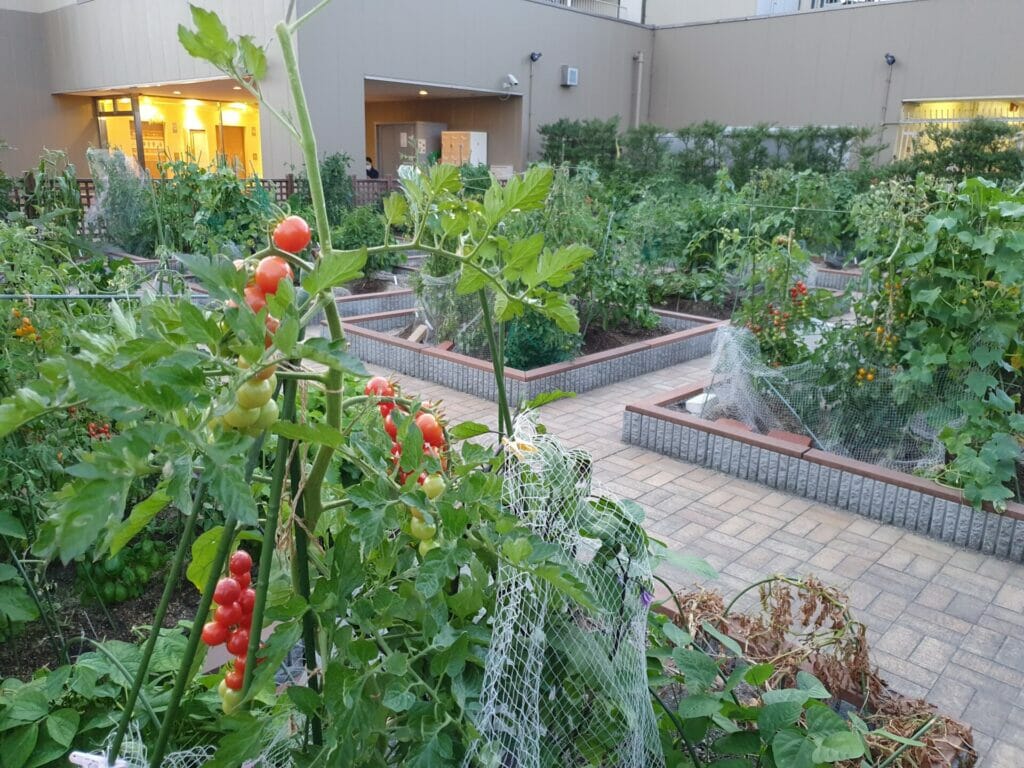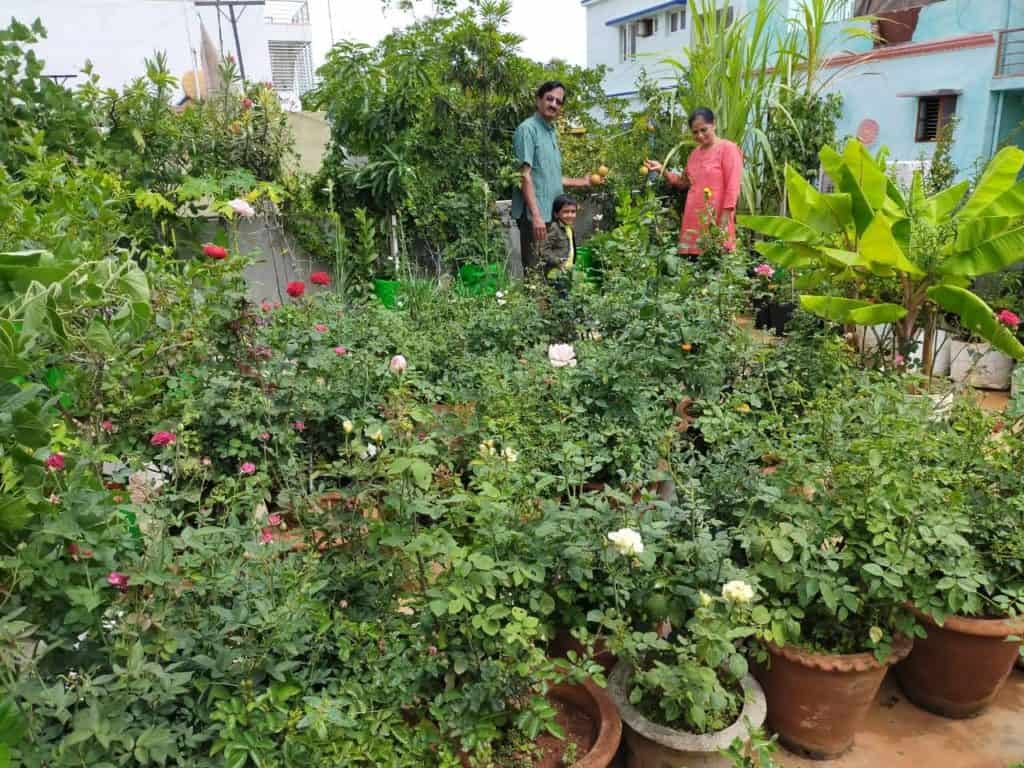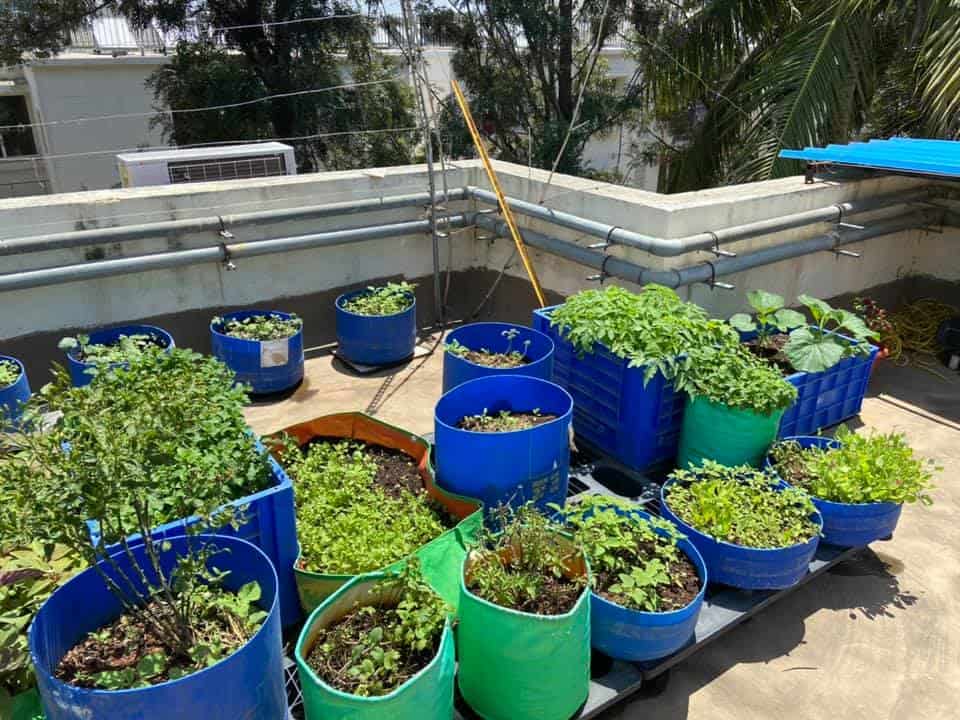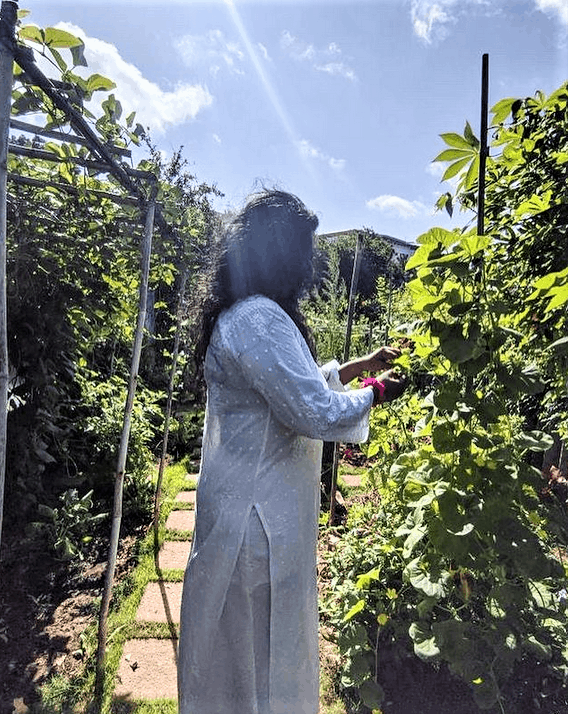- Urban and peri-urban agriculture (UPA) is gaining popularity in Indian metropolises to encourage climate action and sustainable development.
- Though the climate mitigation of UPA may be overstated, an IIT-Madras study found that UPA “can play a small, but not insignificant role” in augmenting carbon stock and bringing down land surface temperatures in cities.
- However, researchers say UPA has other benefits that make it critical for urban planning, such as promoting individual and community well-being, increasing urban food security and creating green jobs.
Every few weeks, 53-year-old agricultural entomologist Rajendra Hegde addresses a large gathering in Bengaluru, where he puts forth a proposition: imagine walking up to your rooftops or balconies and foraging for vegetables and herbs.
It’s an imagination that stems from his childhood memories of his hometown Honnavar in coastal Karnataka, sandwiched between the Western Ghats and the Arabian Sea, where everyone was a home gardener or farmer.
When Hegde moved to Bengaluru in 2002, he felt a sense of disconnection. Only sporadic patches of green remained in a landscape of concrete. Three years later, he joined fellow entomologist Vishwanath Kadur in his mission to convince citizens to take up terrace gardening.
“We wanted to change the foodscape of the city, but there were so many misconceptions about urban agriculture. People thought terrace gardening would damage roofs and that the whole endeavour would be expensive. They didn’t know where to procure seeds, fertilisers and pesticides,” said Hegde.

By 2011, they formed the Garden City Farmers Trust – an organisation that seeks to popularise urban agriculture. Their flagship event, the wildly popular Oota from Your Thota (a Kannada phrase meaning, ‘Food from your garden’), is conducted every three months. The one-day event is held in densely populated residential areas of Bengaluru, and features talks, workshops, stalls and markets focusing on organic urban agriculture. The event is now in its 43rd edition.
“We have reached about 50,000 people through these workshops, who are now growing anywhere between 30-80% of their vegetable requirement in terrace gardens,” said Hegde. “The aim is to have one lakh people take up urban agriculture and make this city more sustainable.”
Read more: How a Bengaluru apartment created a ‘food forest’
A citizen-led urban farming movement
Most Indian cities are currently a mass of unplanned concrete structures, urban heat islands, air pollution and increasing greenhouse emissions. And things are expected to drastically get worse in the coming years.
Urban and peri-urban agriculture (UPA) has started to gain popularity in Indian metropolises as a possible way to break this spiral. By encouraging forms of agriculture and horticulture in and around cities, the hope is to encourage some form of climate action and make the Indian city more sustainable and liveable. Researchers from ICAR-Indian Agricultural Research Institute went so far as to call UPA the “saviour of rapid urbanisation”.
Apart from Oota from your Thota, numerous other similar initiatives have sprung up across other Indian cities. In Chennai, residents of Kasturba Nagar have adopted a neglected patch of shrubs and garbage by their community hall and turned it into a thriving vegetable garden. In Hyderabad, over 600 households enrol annually under a state horticulture department scheme where kits of soil, manure, fertilisers and seeds are provided to encourage urban farming.
In Mumbai, sanitation workers and traditional agriculture workers have been growing fruits and vegetables in the last remaining spaces in the city: from vacant railways land to empty spaces in apartment complexes. Pune has included 18 acres of urban farms as part of their Smart City project; while the non-profit People’s Resource Centre is pushing for an Urban Agriculture Policy in Delhi to protect the informal cultivation of vegetables on the Yamuna floodplains.
Largely, these actions have been citizen-led: either out of necessity, as with the daily-wage agriculture workers in Mumbai, or through self-interest in gardening, as shown by a 2021 survey of urban farmers in Hyderabad.
“Despite a vast national agricultural policy, urban farming has just not entered the minds of policymakers who think of it as a hobby,” said Rajendra Hegde.
Read more: How this Bellandur apartment set up a kitchen garden on the terrace
More than a hobby?
A September 2022 study, by researchers of Indian Institute of Technology-Madras (IIT-M), shows that UPA “can play a small, but not insignificant role” in augmenting carbon stock and bringing down land surface temperatures in cities.
Researchers projected the urban growth trends of Bengaluru and Chennai – cumulatively covering more than 7,000 sq.km. of urbanised land and suburbs – to estimate the growth potential in 2032 and 2041 respectively. These two cities were chosen for their high rate of urbanisation: in Bengaluru, for instance, the built-up area increased from 16% in 2011 to 32% by 2020.
The modelling was complemented by a survey of urban farmers. More than half the farms were less than 300 sq.ft., and the area under urban farming was increasing by 3% annually, the survey showed.
Assuming that 1.25 lakh persons take up urban farming in Bengaluru – a tad more than Garden City Farmers Trust’s ambitions – the mean land surface temperatures was projected to decline by 0.35°C in Bengaluru in 2032. In Chennai, it was a decline of between 0.04°C to 0.07°C degree Celsius.
“This difference between the cities is because the pace of urbanisation is much higher than Chennai,” said Ashwin Mahalingam, a professor in the department of civil engineering at IIT Madras and one of the authors of the paper.
Of more significance, however, is that the increased bio-mass due to urban farming can additionally sequester at least 1.3 lakh tonnes of carbon dioxide in Bengaluru. The numbers are small, but can’t be ignored, says the research paper.
“Small pockets of urban farms do not add to very much. It is certainly not going to push the needle in climate mitigation as compared to sustainable building practices or green transport,” said Mahalingam. “But this does not mean it is not useful. The movement must start somewhere and there are multiple other benefits to urban farming.”

The benefits of peri-urban farming
Mahalingam’s team is finding that peri-urban farms have even greater impacts. One of the potential benefits they are investigating is the reduction in transportation emissions.
Transporting vegetables and fruits from far-off rural areas is carbon intensive, involving trucks and goods vehicles driving hundreds of kilometres. Sourcing them locally can potentially reduce this environmental burden.
The team conducted a lifecycle analysis of Chennai’s demand for tomatoes and brinjals. They modelled the carbon footprint of sourcing these goods from traditional rural farms, peri-urban and urban areas. “The footprint to source these from rural farms is high. But it is also very high to source it from urban farms. Here, the quantity of output is low, but the input — in terms of seeds and fertiliser that need to be sourced from far off places — is high,” said Mahalingam. The findings are yet to be published.

However, peri-urban farms — which surround the city — are in the ‘Goldilocks zone’ in terms of the footprint to transport and the quantity of output. “If cities want to pursue climate change mitigation, they are better off protecting and encouraging peri-urban agriculture,” he said.
But peri-urban agriculture is under immense pressure in India. High land prices make construction of houses and apartments far more lucrative for the landowner than agriculture. There are additional challenges such as low yield due to groundwater and soil pollution and dwindling water sources. Increasing temperatures and variable rainfall will also lead to decline in yield of certain crops, finds a recent study by Indian Institute of Management-Ahmedabad that looked at the potential of horticulture farming in Dehradun, Ahmedabad-Gandhinagar and Panaji. Policy should be designed to aid farmers shift away from crops that will see lower yields due to rising temperatures (like, tomatoes, beans and cabbage) and towards crops whose yields will be stable (potatoes, onions) or will increase (mangoes).
Urban farming as a policy
Despite the relatively low impact in terms of climate change mitigation, urban farming is critical for Indian cities and should be considered by public policy, said Prathigna Poonacha, a researcher at Indian Institute for Human Settlements (IIHS), Bengaluru, and a co-principal investigator with the Urban and Peri-Urban Agriculture as Green Infrastructure (UP-AGrI) project. The research project, being conducted by research institutes in India and Tanzania, aims to examine the ecological and societal impacts of UPA as well as test strategies that allow UPA to contribute to urban sustainability.
“There are multiple benefits in promoting urban gardening and agriculture. For one, there is subjective well-being, particularly in terms of better mental health, of those engaged in urban farming. There is a material benefit of growing a significant proportion of vegetable and herb needs in one’s gardens. Urban farming also contributes to food security and meets a part of nutritional needs. At the city level, urban farming creates thousands of green jobs, particularly for marginalised communities and migrant workers,” said Poonacha.

UP-AGrI is pushing for the National Building Code to make it mandatory to include urban farming as a criterion for Green Building Certification. “There are a lot of opportunities for policy to encourage urban farming, through urban planning that encourages community farming or even through property tax incentives,” she said.
[This story was first published on Mongabay India and has been republished with permission. The original article can be read here]
Hi Mohit,
Nice article. Very good coverage of so many aspect.
I am interested in using vacant plots in layouts, such as Tropical Paradise behind HSR layout, as plots for urban farming or orchards. It can be a source of revenue for the garderners who do the work. It would also help the owners in keeping the plot clean and green. If there is any such group of garderners in that area, can you please introduce me to them?
I don’t live there but I have been growing fruits in Tropical Paradise with help of one garderner. He and others can cover more such plots. We have done rainwater harvesting there using surface run off. That is enough for about 3/4th of the year. So we have some experience but need some willing people to take our experience forward into making it happen in that layour or other layouts.
Thanks
Vivek
Terrace gardening: (1) Caution – The article is interesting and most Bengalureans are fond of having some green around them. My own experience is that in my enthusiasm I grew my most organic leafy greens and vegetables on my terrace including a Singapore Cherry tree in a large drum with regular watering. After two years, I found that the roof plaster cracking, peeling and falling in many places. An Engineer friend warned me and even if I get the roof waterproofed, I must restrict my habit to the minimum greening effort.
(2) Suggestion – In urban areas, we find many vacant sites since the owners’ own problems and they have either become waste dumping yards or Urinating places or being occupied illegally. Those living next to such sites may consider this – Owner may be contacted with a request that the site will be taken care of by them by converting it into a mini-garden by fencing etc., and that any time the owner wants the site back, it will be returned without any conditions. This way, the owner’s site will be safe, greening effort will be successful, misuse and unhealthy neighborhood conditions can be avoided. Such greens must be careful in not planing species that grow into large size and may inconvenient the owner when it is being handed over. Our roof will also be safe!! Owner can also escape municipal tax being levied as vacant site clearing tax. It could be a win-win situation for self (organic greens, vegs, tomato (?) owner(site is safe, no anxiety and tax escape) and Bengalureans (sequestration of CO2, visual happiness).
(3) The above idea applies to vacant government lands also (many MNCs are taking care of parks etc., under CSR); Group of neighborhood greens may approach concerned owner department and take care.